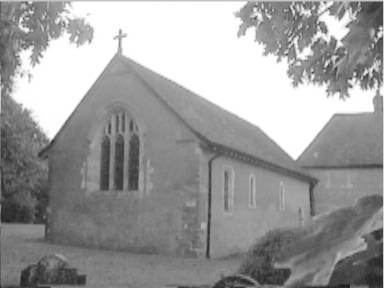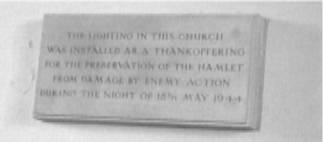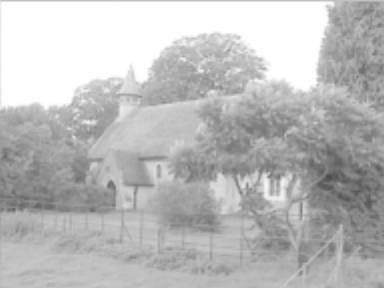![]()

![]()
32. St Nicholas West Worldham and St Leonard's Hartley Mauditt
In the heart of the Hampshire countryside north of Selborne and 'far from the madding crowd' stand two small churches in splendid isolation and only a mile apart.

St Nicholas, West Worldham
13th century St Nicholas, although only 44 feet long and 18 feet wide, has considerable charm. In the 1870's it fell into ruin only to be fully restored in 1888 by Winchester College, whose connection with the church dates back to its purchase by William of Wykeham in 1414, at which time the porch over the South Door was added. Apparently the church also came under threat during World War Two. A plaque on the south wall of the nave states that electric lighting was installed as a 'thank offering for the preservation of the hamlet from damage by enemy action during the night of 15 May 1944'. Surely the Luftwaffe did not attempt a blitzkrieg on West Worldham?

Most of the glass in the church is plain except for the two light windows South of the altar which contain stained glass showing St Nicholas and WIlliam of Wykeham, placed there in 1888 in memory of the Turvill family. The fifteenth century West Window, which overlooks the adjoining sixteenth century farmhouse, contains some interesting fragments of 17th century glass. Here can be seen a parrot, a dove, a robin, a lamb, grapes, a rose and acorns as well as the mermaid from the coat of arms of Nicholas Mason. Fined £412 for being a Royalist in 1650, three years later he presented the first register to the church, a photo of the frontispiece being on display below the window.
There are a number of memorial tablets to the Hammond family who were local farmers. One poignant one is to two brothers, William and John Hammond. William died aged 28 in 1786, his brother a year later, aged 26.
"Weep not our friends nor Children dear
Two loving brothers
slumber here.
In love they liv'd in peace they died
their lives defir'd
but God denyd."
Anne, the widow of William, died 58 years later in 1844 aged 81.
On the altar floor are eighteenth century memorials to Joseph White and his family.
The font of plain octagonal shape, obviously medieval, but the red tiled floor, the pews and the timbered roof all date from the Victorian restoration.

St Leonard's, Hartley Mauditt
A mile away opposite Hartley Pond, stands St Leonard's Church, but the manor house and the village have long since disappeared. The name Mauditt derives from William de Mauditt, granted the manor by William the Conqueror, and whose name appears in the Domesday Book. The church was probably built by William between 1100 and 1125.
The interior is spacious and with a high timbered roof. There is a very fine horseshoe shaped chancel arch and above it the Royal Arms of George II are displayed. The 15th century font, probably presented when the Earls of Lancaster held the manor, has the Lancashire Rose carved in the tracery as well as a more unusual horseshoe.
A memorial on the South Wall of the nave is unusual in that it commemorates a servant, Thomas Lightharness, who died in 1679 after being butler to Sir Nicholas Stuart, Lord of the Manor, for 25 years. It was placed there by his nephew Richard Gilliver and states that "he showed during his whole service all good fidelity to God and in his constant attendance to y offices of his church exemplary religion and to his own relations singular piety."
The square ended 13th century chancel contains several magnificent 17th and 18th century Latin memorials to members of the Stuart family who lived in the Manor House between 1614 and 1790. Surrounded by highly coloured crests and heraldic devices the largest has a marble panel underneath showing how Sir Nicholas Stuart won his escutcheon fighting in France whilst serving in exile with King Charles II. After the Restoration his confiscated lands were returned and he was created a baronet.
The predominately blue glass in the East Window is Victorian and shows scenes from the Crucifixion and Ascension. Another window in the South Chancel depicts the figure of Charity in red robes in memory of Florence Stuart who died in 1926, as well as a window in memory of Emily Plummer (1908) showing two nun-like figures. To the right of the altar is a fourteenth century piscina and to the left an aumbry of similar date. The floor tiles are Victorian. At the back of the church behind the font is a beautifully inscribed list of all the rectors and patrons beginning with Nicholas de Warwyck in 1220 and ending with Victor Earwick in 1977.
From the churchyard notice the attractive wood shingled bell turret, a Victorian replacement of a 14th century stone turret, but its little spire and weather cock adds to the appearance of the church. Sadly the ancient bell, dated 1601, was stolen from the belfry in 1970 and has never been recovered.
John Symonds
![]() Return to the October 1999 Features page
Return to the October 1999 Features page
![]() return to Home page and main index
return to Home page and main index
page last updated 2 OCTOBER 1999